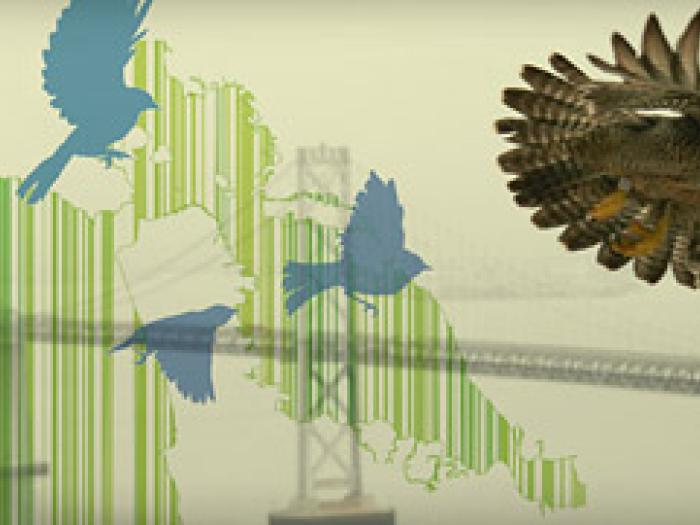
Standards for Bird-Safe Buildings
Project Status: Completed in 2011
Over thirty years of research has proven that buildings are a "biologically significant" risk for certain bird species and bird safe environments. Annual bird fatalities in North America from window collisions may be as high as 1 billion birds per year or 1-5% of all birds. While the facts are staggering, the solutions are within reach. The majority of these deaths are foreseeable and avoidable. The Standards for Bird-Safe Buildings explains the documented risks that structures present to birds and how best to approach possible solutions.
The Standards for Bird-Safe Buildings explains the documented risks that structures present to birds. Over thirty years of research has proven that buildings are a "biologically significant" risk for certain bird species. Annual bird fatalities in North America from window collisions may be as high as 1 billion birds per year or 1-5% of all birds. While the facts are staggering, the solutions are within reach. The majority of these deaths are foreseeable and avoidable. San Francisco's Standards summarizes proven remedies such as window treatments, lighting design, and lighting operation. The document proposes a three-pronged approach to the problem:
- establishment of requirements for the most hazardous conditions; ( pg. 28 of Standards for Bird-Safe Buildings )
- use of an educational checklist to educate project sponsors and their future tenants on potential hazards; and ( pg. 38 of Standards for Bird-Safe Buildings )
- creation and expansion of voluntary programs to encourage more bird-safe practices including acknowledging those who pursue certification through a proposed new program for "bird-safe building" recognition. ( pg. 33 of Standards for Bird-Safe Buildings )
September 2011 Board of Supervisors Hearing Materials:
July 14, 2011 Commission Hearing Materials:
Documents
- Adopted Ordinance
- Adopted Standards for Bird-Safe Buildings
- Design Standards for Bird-Safe Buildings
- Urban Bird Refuge Poster
Bird-Safe Buildings in the Media:
Publications Cited in Draft Bird-Safe Buildings
- Banks, Richard. 1979. Human Related Mortality of Birds in The United States. United States Department of the Interior Fish and Wildlife Service. Special Scientific Report--Wildlife No. 215.
- Bower, Joe. 2000. The Dark Side of Light. Audubon. Vol. 102(2): 92-94.
- Eisenberg, Anne. 2010. Warning to Birds: All-Glass Buildings Ahead. New York Times. Aug. 28, 2010. LINK:http://www.nytimes.com/2010/08/29/business/29novel.html
- Gelb, Yigal; Nicole Delacretaz. 2009. Windows and Vegetation: Primary Factors in Manhattan Bird Collisions. Northeastern Naturalist. 16(3):455-470.
- Hager, Stephen, B., Heidi Trudell, Kelly J. McKay, Stephanie M. Crandall, and Lance Mayer. 2008. Bird Density and Mortality at Windows. The Wilson Journal of Ornithology. 120(3):550-564.
- Kay, Jane. February 23, 2009. San Francisco is a Bird Watcher’s Paradise. San Francisco Chronicle. LINK:http://articles.sfgate.com/2009-02-23/bay-area/17191041_1_birding-spots-western-bluebird-western-screech
- Klem, D. Jr. February, 1990. Collisions Between Birds and Windows: Mortality and Prevention. Journal of Field Ornithology. 61(1): 120-128.
- Klem, D. Jr. February, 2009. Avian Mortality At Windows: The Second Largest Human Source of Bird Mortality on Earth. Proceedings of the Fourth International Partners in Flight Conference: Tundra to Tropics. 244-251.
- Klem, D. Jr, Christopher Farmer, Nicole Delacretaz, Yigal Gelb, Peter Saenger. 2009. Architectural and Landscape Risk Factors Associated with Bird-Glass Collisions in an Urban Environment. The Wilson Journal of Ornithology. 121(1):126-134.
- Kousky, Carolyn. 2004. A Building Less Bright. Terrain Issue 15. Retrieved from: http://www.terrain.org/articles/15/kousky.htmon 9/15/10.
- Longcore, Travis, Ph.D. et al. February 2005. Scientific Basis to Establish Policy Regulating Communications Towers to Protect Migratory Birds. WT Docket No. 03-187, Federal Communications
- McAdams, E. J. December 2003. Rebuilding Lower Manhattan: A Bird’s-Eye View. Presented by New York City Audubon to Lower Manhattan Development Corporation. Retrieved from:www.yigalgelb.com/site/pdf/ProjectSafeFlightBackgroundInfo.doc on 4/22/11.
- O’Connell, Timothy. Fall 2001. Avian Window Strike Mortality at a Suburban Office Park. The Raven. Vol 72(2): 141-149.
- Ogden, Lesley, J. September, 1996. Collision Course: The Hazards of Lighted Structures and Windows to Migrating Birds. A Special Report for the World Wildlife Fund Canada and the Fatal Light Awareness Program.
- Poot, H., B. J. Ens, H. de Vries, M. A. H. Donners, M. R. Wernand, and J. M. Marquenie. 2008. Green Light for Nocturnally Migrating Birds. Ecology and Society 13(2): 47. Retrieved from: http://www.ecologyandsociety.org/vol13/iss2/art47/ on 9/15/10.
- Scriber, Brad. 2008. “Light Pollution”, “Ecological Light Pollution”, “Got Milky Way”, “Getting Back in Black”, “Nighttime Savings”, and “Lights and Safety”. Nat. Geographic Magazine (October 17, 2008). Retrieved from:http://ngm.nationalgeographic.com/geopedia/Light_Pollution on 9/28/10
- Smallwood, K. Shawn. 2010. Fatality Rates in the Altamont Pass Wind Resource Area 1998-2009. Retrieved at:http://www.altamontsrc.org/alt_doc/p145_smallwood_fatality_monitoring_results_12_31_09.pdf on 9/29/10.
- United States Fish and Wildlife Service. January 2002. Migratory Bird Mortality: Many Human-Caused Threats Afflict Our Bird Populations
Program
Joshua Switzky
Acting Director of Citywide Policy
joshua.switzky@sfgov.org
Implementation
Andrew Perry
Senior Planner
andrew.perry@sfgov.org
